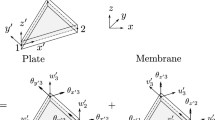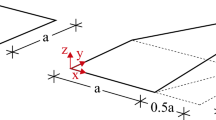Abstract
A new quadrature scheme and a family of hierarchical assumed strain elements have been developed to enhance the performance of the displacement-based hierarchical shell elements. Various linear iterative procedures have been examined for their suitability to solve system of equations resulting from hierarchic shell formulations.
Similar content being viewed by others
References
Babuska, I.; Szabo, B. A.; Katz I. N. 1981: The p-version of the finite element method. SIAM J. Numer. Anal. 18: 512–545
Baker, V. A.; Axelsson, O. 1984: Finite Element Solution of Boundary Value Problem. Academic Press Inc. NY
Bank, R. E.; Dupont, T. F.; Yserentant, H. 1988: The hierarchical basis multigrid method. Numer. Math. 52: 427–458
Belytschko, T.; Stolarski, H.; Liu, W. K.; Carpenter, N.; Ong, J. S.-J. 1985: Stress projection for membrane and shear locking in shell finite elements. Comp. Meth. in Appl. Mech. and Engg. 51: 221–258
Brandt, A. 1977: Multi-level adaptive solutions to boundary-value problems. Mathematics of Computation, 31: 333–390
Carnevali, P.; Morris, R. B.; Tsuji, Y.; Taylor, G. 1992: New Basis Functions and Computational Procedures for p-type Finite Element Analysis. RJ 8710 (78272) Engineering Technology. April 3, 1992
Hinnant, H. E. 1993: A Fast method of numerical quadrature for p-version finite element matrices. A.I.A.A. 1386.
Holzer, S.; Rank, E.; Werner, H. 1990: An implementation of the hp-version of the finite element method for Reissner-Mindlin plate problems. Int. J. Numer. Methods Eng. 30: 459–471
Hughes, T. J. R. 1987: The Finite Element Method. Prentice-Hall.
Park, K. C.; Stanley, G. M. 1986: A curved C 0 Shell element based on Assumed Natural Coordinate Strains. J. of Appl. Mech. 108: 278–290
Ramm, E.; Stander, N.; Matzenmiller, A. 1989: An assessment of Assumed strain methods in finite rotation shell analysis. Eng. Comput. 6
Shephard, M. S.; Dey, S. 1994: Geometric mapping of finite elements on shell geometry. SCOREC report 15
Stanley, G. M.; Levitt, I.; Stehlin, B.; Hurlbut, B. 1992: Adaptive Analysis of Composite Shell Structures via Thickness-tailored 3D Finite Elements. Winter Annual Meeting Anaheim, CA, November 11–13, 1992
Surana, K. S.; Sorem, R. M. 1991: p-version hierarchical three dimensional curved shell element for elastostatics. Int. J. Numer. Methods Eng. 31: 649–676
Szabo, B. A.; Sahrmann, G. J. 1988: Hierarchic plate and Shell models based on p-extensions. Int. J. Numer. Methods Eng. 26: 1855–1881
Szabo, B. A.; Babuska, I.; Chayapaty, B. K. 1989: Stress computations for nearly incompressible materials by the p-version of the Finite Element method. Int. J. Numer. Methods Eng. 28: 2175–2190
Zeinkiewicz, O. C.; Craig, A. 1986: Adaptive Refinement, Error Estimates, Multigrid Solution, and Hierarchic Finite Element Method Concepts. In Babuska, I. Zeinkiewicz, O. C. Gago, J.; Oliveira, E. R. de A. eds. Accuracy Estimates and Adaptive Refinements in Finite Element Computations
Author information
Authors and Affiliations
Additional information
Communicated by S. N. Atluri, 28 April 1995
Rights and permissions
About this article
Cite this article
Fish, J., Guttal, R. The p-version of finite element method for shell analysis. Computational Mechanics 16, 328–340 (1995). https://doi.org/10.1007/BF00350722
Issue Date:
DOI: https://doi.org/10.1007/BF00350722




